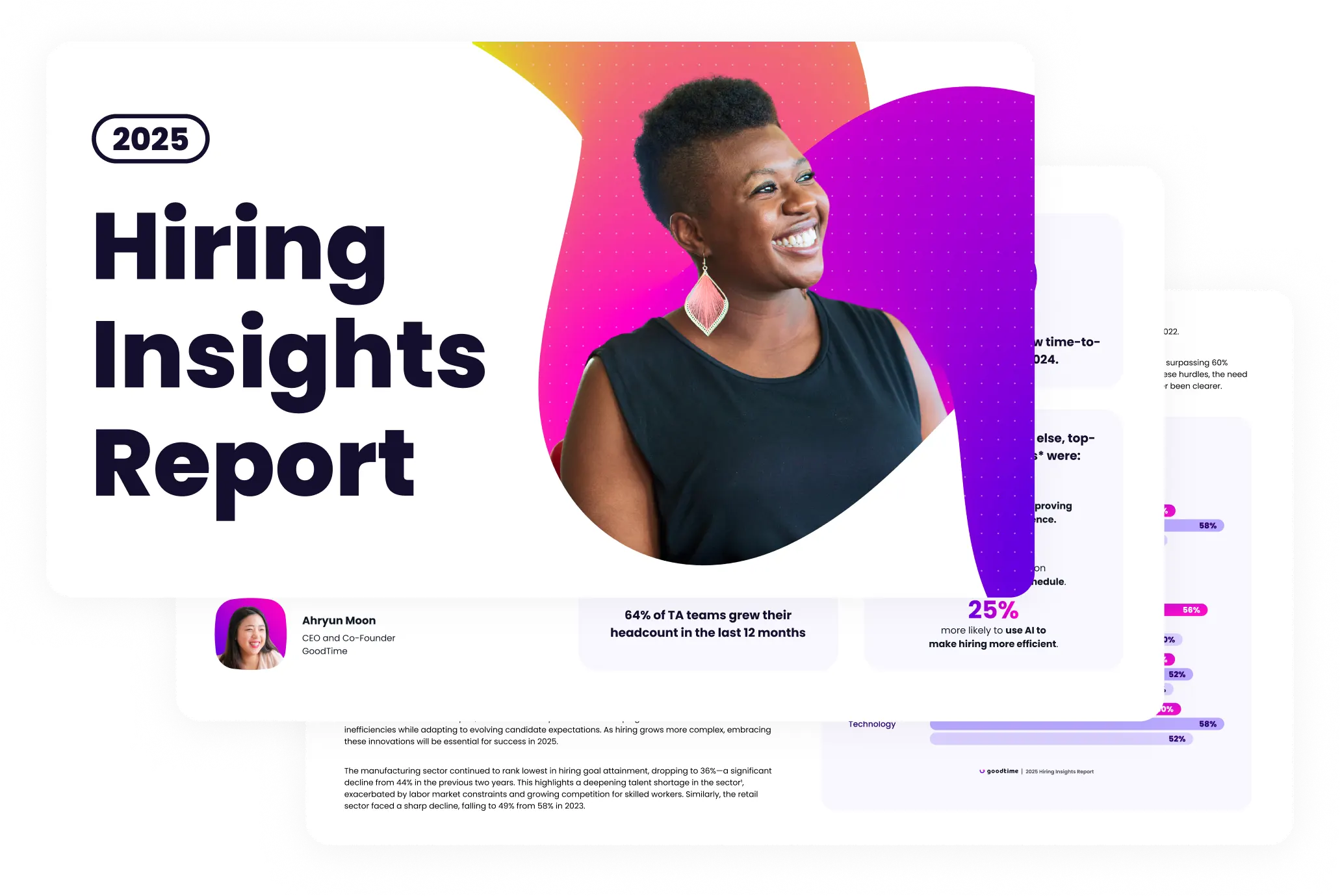Candidate dropout rates during the hiring process are a growing concern for talent acquisition professionals. Losing top candidates mid-process can be frustrating and costly, especially when the labor market is tight.
Picture investing weeks or even months into finding the perfect hire only to see them vanish without a trace. The impact on business goals and team morale is real. Why does this happen, and what can we do about it?
Even with a tentatives commitment made, they can lose interest if the hiring journey drags on — delays, poor communication, or a confusing process can drive them away.
Understanding why candidates drop out is the first step in solving this problem. Let’s get into the causes and actionable solutions to keep top talent engaged.

Unlock 2025’s top hiring strategies: Insights from 500+ TA leaders
Be the first to uncover deep hiring insights specific to your sector — straight from the highest-performing TA teams.

Why candidates drop out
Candidates today have more options than ever, and they know it. If the hiring process steps feel frustrating or overly complicated, they’ll simply move on to the next opportunity.
A lengthy, confusing application or poor communication can quickly discourage top talent. They want a smooth, transparent experience where they feel valued at every step.
If they don’t get that, they might drop out without a second thought. When you understand the common pitfalls that lead candidates to walk away, like unclear expectations and slow response times, you can make improvements that encourage them to stay engaged and committed throughout the process.
Here are some of the reasons candidates drop out:
1. Lengthy hiring processes
A drawn-out hiring process is a major culprit. Interestingly, roughly 62% of candidates lose interest if the process takes too long. Let’s say you receive a stellar letter of recommendation and an employment reference letter, only to wait weeks for interview scheduling. But by the time you reach a decision regarding scheduling an interview, another company has already made an offer.
Candidates don’t just want efficiency; they expect it.
2. Lack of communication
Silence can be deafening. When candidates don’t know what’s happening, they feel undervalued. Think of it like waiting for a response after providing a recommendation letter sample. The longer the silence, the more likely the candidate will move on.
3. Negative candidate experience
An unorganized or confusing hiring process sends a clear message: “We don’t value your time.” Everyone expects their candidate experience to be smooth and professional, and when things are chaotic — whether it’s unclear timelines or last-minute rescheduling — they start to question the company’s priorities.
Not only does this reflect poorly on the company, but candidates may also wonder if the same disorganization is present in the company’s culture or day-to-day operations.
A negative experience leaves a lasting impression and could lead candidates to believe that the company isn’t a place where they would want to work. This disconnect is more than just an inconvenience; it could be a dealbreaker for top talent who are evaluating your company alongside other opportunities.
4. Misleading job descriptions
If the job description doesn’t accurately reflect the role’s duties or expectations, candidates may decide to drop out after applying. For instance, an overly broad description or vague qualifications can set unrealistic expectations, leading to dissatisfaction when the role doesn’t match what you promised.
5. Unclear or unattractive compensation
Candidates often abandon applications if the salary or benefits package isn’t clear upfront. A lack of transparency about compensation or a mismatch between the role and the candidate’s salary expectations can be a major deterrent in the hiring process.
6. Slow response time
If the hiring manager is slow to respond to candidates after they apply, or if there are long delays between interview stages, candidates may assume they are not a priority and lose interest. Fast and efficient communication can help maintain candidate engagement throughout the process.
7. Unprofessional interview process
A disorganized or unprofessional interview process can make candidates feel undervalued. A lack of preparation or a negative interaction with interviewers can lead to candidates losing trust in the prospective employer.
8. Better offers from competitors
In a competitive job market, candidates may withdraw from the process if they receive a more attractive offer from another company. This highlights the importance of making swift decisions and offering competitive packages.
Understanding all of these reasons is half the battle. The main headache for employers and recruiters in the hiring funnel is keeping top candidates engaged and excited about joining their team.
Solutions to prevent candidate dropouts
To reduce candidate dropouts, employers must take proactive steps to improve the hiring process and the overall candidate experience. If you address the main reasons candidates withdraw, including lengthy applications and poor communication, your company can create a more engaging and efficient recruitment process.
Implementing effective solutions helps reduce drop-out rates and makes sure that top talent stays engaged throughout the hiring journey. Here are some effective solutions to prevent candidate dropouts in the hiring process:
1. Move fast and minimize time-to-hire
Speed matters. In a competitive job market, efficiency can be the deciding factor between securing a top candidate and losing them to a competitor. Tools like GoodTime’s customizable recruiting automation software make it easy to streamline the process and reduce delays.
Automated scheduling eliminates the back-and-forth emails that waste precious time. Candidates appreciate a smooth, quick process. Acting swiftly shows candidates that you respect their time and are serious about bringing them on board.
Efficiency in hiring isn’t just a nice thing; it’s a competitive necessity. This raises the question, “Are you moving fast enough to keep your top candidates engaged?”
2. Maintain consistent engagement
Communication can make or break the hiring experience. Regular updates help candidates feel connected and informed. Simple strategies such as using text recruiting software to send status updates via SMS, WhatsApp, or email can keep engagement levels high.
If you communicate frequently, candidates know exactly where they stand. Transparency about timelines and next steps builds trust.
It’s the same case as keeping someone updated after requesting a recommendation letter or providing a recommendation letter sample. When they know what’s happening, they are more likely to stay committed.
3. Focus on candidate experience
An organized and engaging hiring process leaves a positive impression. Candidates typically don’t forget how you treated them. Was the interview panel ready? Did you greet them warmly? Did everything run as planned during the intake meeting?
A seamless experience isn’t just polite. It shows what working at your company is like. Use tactics like candidate experience surveys to identify pain points and improve the process. When candidates feel valued, they are more likely to stay the course.
Additional strategies to retain candidates
Sometimes, the details make the difference. Consider these additional approaches to keep candidates engaged:
1. Personalized interactions
Treat candidates like individuals, not numbers. Tailor your communication to their unique skills and background.
If a candidate shares a letter of recommendation highlighting specific achievements, reference those achievements in your interactions. Personal touches show that you’re paying attention and genuinely interested.
2. Showcase company culture early
Candidates want to know what it’s like to work at your company. Share your culture through employee testimonials or virtual office tours. Give them a glimpse of your team’s dynamic and values. When candidates see a culture they connect with, they are more likely to stay engaged.
3. Competitive offers
Salary isn’t everything, but it’s important. If you want to preempt counteroffers, present a great compensation package early in the process. Remember to highlight benefits, growth opportunities, and perks. When candidates feel your offer is competitive, they’re less likely to entertain opportunities from other employers.
Efficiency and engagement win top talent
Efficiency and engagement are key to attracting and retaining top talent in a competitive job market. When candidates drop out of the hiring process, it wastes valuable time and resources.
However, dropouts are preventable with a focus on speed, communication, and candidate experience. Candidates today expect transparency, timely feedback, and a seamless application process. They want to feel valued throughout their journey, just as employers want to assess their skills for the role.
At GoodTime, we believe that keeping the candidate experience engaging and efficient is the foundation for strong employer branding and securing top talent. We have successfully embraced AI recruitment tools to streamline scheduling and communication, guaranteeing a smooth process that keeps candidates excited and committed every step of the way. Eliminating delays, simplifying scheduling, and maintaining an open line of communication helps employers build stronger relationships with candidates, leading to a more successful hiring outcome.
If you invest in these solutions, you’re not just speeding up your recruitment process; you’re also improving your reputation as an employer who values and respects candidates’ time and efforts. This creates a foundation for long-term success, where top talent is eager to join your team.
Book your demo today to learn how our solutions can revolutionize your recruitment programs. Don’t let candidates drop out.





